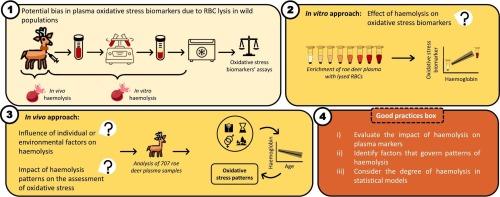溶血会高估散养哺乳动物的血浆氧化应激生物标志物:以狍子为例。
IF 2.1
3区 生物学
Q4 BIOCHEMISTRY & MOLECULAR BIOLOGY
Comparative Biochemistry and Physiology A-Molecular & Integrative Physiology
Pub Date : 2024-09-21
DOI:10.1016/j.cbpa.2024.111750
引用次数: 0
摘要
自从氧化应激被认为是生活史的中介因素以来,氧化应激的量化在进化生态学和生理学中引起了广泛的兴趣。然而,虽然氧化应激生态学的理论框架得到了实验室研究的充分支持,但在野生种群中获得的氧化损伤和抗氧化生物标志物的结果却显示出不一致的趋势。我们提出,红细胞溶解可能是影响氧化应激生物标志物测量的一个偏差来源,从而扭曲了由此得出的结论。我们采用一种实验方法,用溶解的红细胞富集狍血浆,结果表明,常用的氧化应激生物标志物的值随溶血程度(通过血红蛋白浓度进行测定)的增加而线性增加。这一结果涉及氧化蛋白质(羰基)和脂质(TBARS),以及酶(超氧化物歧化酶)和非酶(trolox 试验、OXY 试验)抗氧化标志物。根据在野外采集的 707 份狍子血液样本,我们发现血浆样本中溶血现象的发生与年龄呈负相关。最后,我们说明,考虑与年龄相关的溶血所解释的方差可以改进血浆氧化应激生物标志物个体间变异的解释模型,而不会大幅改变本文所研究参数的估计值。在狍子等动物模型中,溶血的发生和严重程度因个体特征而异,如果不考虑血浆中的溶血程度,我们的研究结果就会引起结论的真实性问题。我们建议,今后在生态生理研究中调查氧化应激的原因和后果时,应考虑测量和控制溶血程度。本文章由计算机程序翻译,如有差异,请以英文原文为准。

Haemolysis overestimates plasma oxidative stress biomarkers in free-ranging roe deer
Quantifying oxidative stress has garnered extensive interest in evolutionary ecology and physiology since proposed as a mediator of life histories. However, while the theoretical framework of oxidative stress ecology is well-supported by laboratory-based studies, results obtained in wild populations on oxidative damage and antioxidant biomarkers have shown inconsistent trends. We propose that red blood cell lysis could be a source of bias affecting measurements of oxidative stress biomarkers, distorting the conclusions drawn from them. Using an experimental approach consisting of enriching plasma from roe deer with lysed red blood cells, we show that the values of commonly used oxidative stress biomarkers linearly increase with the degree of haemolysis – assayed by haemoglobin concentration. This result concerns oxidized proteins (carbonyls) and lipids (TBARS), as well as enzymatic (superoxide dismutase) and non-enzymatic (trolox assay, OXY assay) antioxidant markers. Based on 707 roe deer blood samples collected in the field, we next show that the occurrence of haemolysis in plasma samples is negatively related to age. Finally, we illustrate that considering the variance explained by age-related haemolysis improves explanatory models for inter-individual variability in plasma oxidative stress biomarkers, without substantially altering the estimates of the parameters studied here. Our results raise the question of the veracity of the conclusions if the degree of haemolysis in plasma is not considered in animal models such as roe deer, for which the occurrence and severity of haemolysis vary according to individual characteristics. We recommend measuring and controlling for the degree of haemolysis be considered in future studies that investigate the causes and consequences of oxidative stress in ecophysiological studies.
求助全文
通过发布文献求助,成功后即可免费获取论文全文。
去求助
来源期刊
CiteScore
5.00
自引率
4.30%
发文量
155
审稿时长
3 months
期刊介绍:
Part A: Molecular & Integrative Physiology of Comparative Biochemistry and Physiology. This journal covers molecular, cellular, integrative, and ecological physiology. Topics include bioenergetics, circulation, development, excretion, ion regulation, endocrinology, neurobiology, nutrition, respiration, and thermal biology. Study on regulatory mechanisms at any level of organization such as signal transduction and cellular interaction and control of behavior are also published.

 求助内容:
求助内容: 应助结果提醒方式:
应助结果提醒方式:


